Just five hours away from Toronto is a Europe-like getaway that has something for everyone, including the baby boomers and millennial siblings accompanying me on a week-long trip to Montreal.
A cosmopolitan city, Montreal is conflux of French, Quebecois and English culture, along with the more recent influx of Arab, Italian and Chinese culture. A vibrant city that celebrates and embraces diversity, it is home to a dynamic arts and culture scene and architectural structures akin to those found across Europe. These are just some of the reasons that make Montreal a must-visit destination on your next trip to Canada.
Explore the city
With most places accessible by foot and via the public transportation system, it is definitely worth spending a few days immersing yourself in the vibe of the city. Owing to the large youth population, the city has a hip and bohemian vibe that adds to the experience. Plan a visit during the summer and you are sure to witness, in its entirety, what Montreal has to offer — music festivals, cultural events and fireworks galore.
The Festival International de Jazz de Montreal, held from late June to early July, brings together jazz, rock and pop artists and is touted as North America’s top music festival. The Grand Prix du Canada, also held over the summer, is one of the most anticipated and crowd-packed Formula One races in the world.
If that is not your thing, visit one of Montreal’s many roof-top cafés and, amid stunning views of the city, sample some of the best food in the country. For art connoisseurs, there is a plethora of art galleries, such as the Montreal Museum of Fine Arts or the Fashion Museum.
Marvel at the city’s architectural delights
It is a city where the old and new coexist together. Montreal is characterized by narrow streets, cobblestone roads, skyscrapers and age-old cathedrals. Take a horse-cart ride around the French colonial Vieux-Montreal and marvel at historical structures like the Old Port of Montreal, Victoria Square, the Gothic Revival-style Notre-Dame Basilica or the city’s oldest bank building, the Bank of Montreal Museum. Fun fact, filmmakers in Montreal often use the area as a setting for period films and documentaries that depict Europe.
Walk further down Saint Jacques Street, a financial and commercial hub that headquarters some of Canada’s biggest banks, or visit the RÉSO, commonly referred to as The Underground City, a complete city with shopping complexes, restaurants and an interconnected transit system built entirely underground. To the northeast, the Jean-Talon Market is one of the oldest public markets in the city. It sells seasonal produce, fresh meats, artisanal cheese and baked goods and is perfect for a day of enjoying the sights, smells and tastes of products from all over Canada.
Be at one with nature
The city is home to many green spaces, parks and lakes. The Mount Royale (after which the city is named) peak and park is perhaps the most famous. Ride a bike, take a hike or plan a picnic in the beautiful surroundings. Montreal also boasts one of the largest botanical gardens in Canada, with thematic spaces, including the serene Chinese and Japanese gardens. The Montreal Biodôme showcases ecosystems, natural heritage and animal life in North America. It houses animals and birds from varying ecosystems such as lush tropical rainforests and subpolar regions. The Insectarium, the largest insect museum in North America, is an opportunity to learn about the natural habitat of insects. This summer, there is a new exhibit that curates insect delicacies for visitors to try out. So, are you feeling adventurous?
Montreal is full to the brim of joie de vivre and well-worth a visit if you are keen to explore nature and enjoy art, food and music galore.
Explore Montreal, a European-style getaway in North America
Explore Montreal, a European-style getaway in North America

Saudi traditional crafts on show at Jouf camel auction

- Women demonstrate art of making sameel storage pouches
RIYADH: The art of making leather containers for storing food and drinks was just one of the attractions at the recent Jouf camel auction in Dumat Al-Jandal governorate.
With 2025 designated as the Year of Handicrafts, festivals across Saudi Arabia are providing important platforms for artisans to showcase and market their traditional skills.
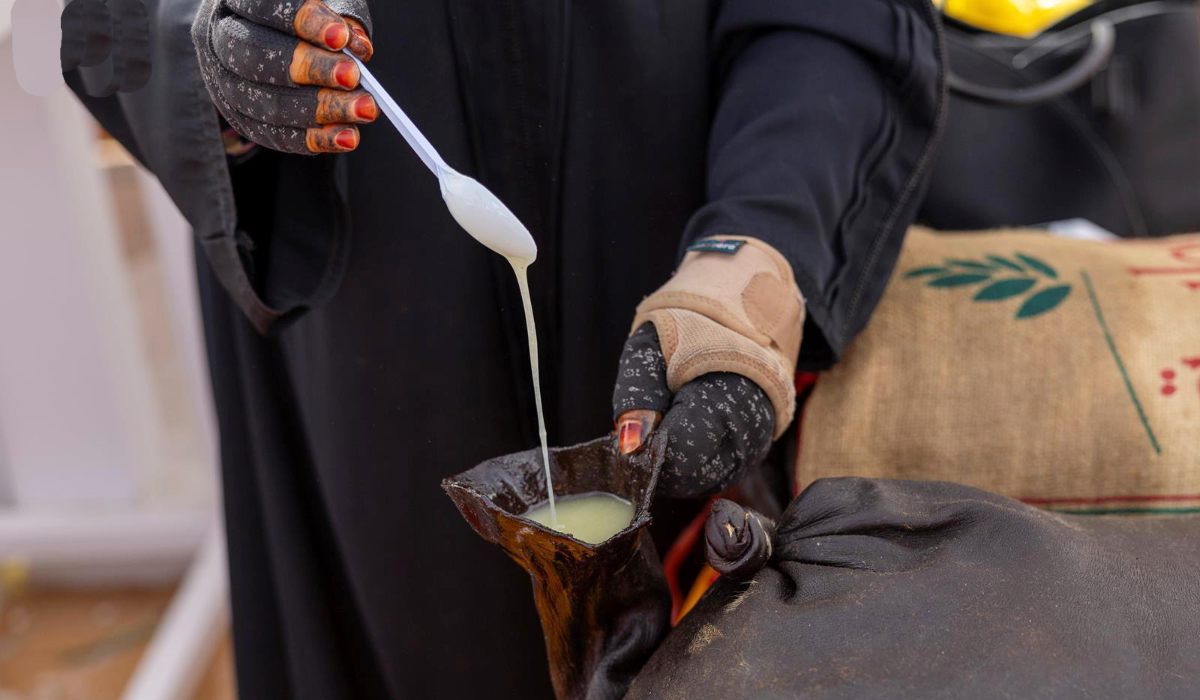
At the camel auction, which ends on Tuesday, craftswoman Umm Meshaal, told the Saudi Press Agency how she produced sameel, a type of pouch made from animal hide and used for storing ghee, yogurt and water.
Meshaal said that sheep skin worked best for keeping yogurt, while goat skin was better for ghee.
FASTFACTS
• At the Jouf camel auction, craftswoman Umm Meshaal told the Saudi Press Agency how she produced sameel.
• It is a traditional pouch made from animal hide and used for storing ghee, yogurt and water.
The process starts by tanning the skins using a tree extract and salt to remove the hair and any impurities. The hides are then left to dry before being cut and sewn together into the desired shape.
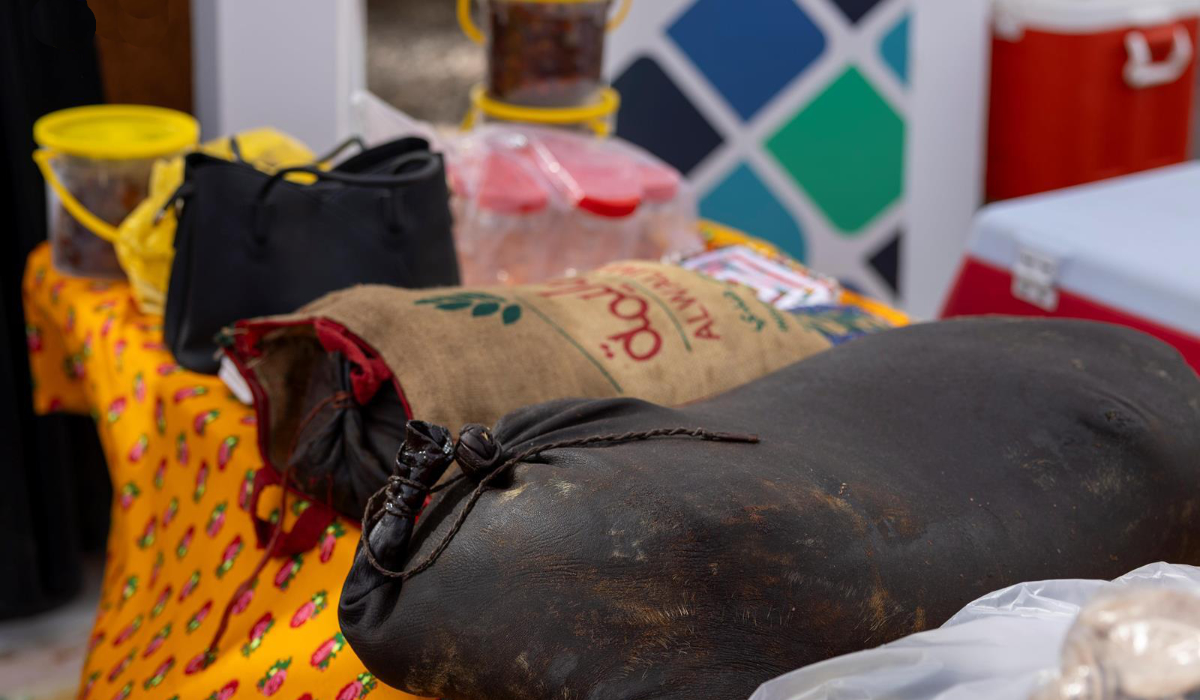
The ancient art of making sameel is still relevant in modern-day Jouf, particularly among Bedouin communities who use them for storing and carrying vital supplies.
Many consumers say the best ghee in the Kingdom comes from these traditional vessels, the report said.
A look at NEOM’s prehistoric masterpieces etched in stone

- Open-air museum of ancient artworks is key to decoding past civilizations
- Drawings reveal how human beings interacted with now-extinct animals in the area
MAKKAH: In the heart of NEOM’s Hisma Desert, where sandstone mountains and plateaus rise from the arid landscape, is an extraordinary collection of ancient rock art and archaeological inscriptions. These priceless treasures illuminate the cultural and economic vitality of long-lost civilizations.
Once a vital corridor for caravans travelling the ancient trade routes of the Arabian Peninsula, this region preserves an invaluable legacy etched into its geological formations.
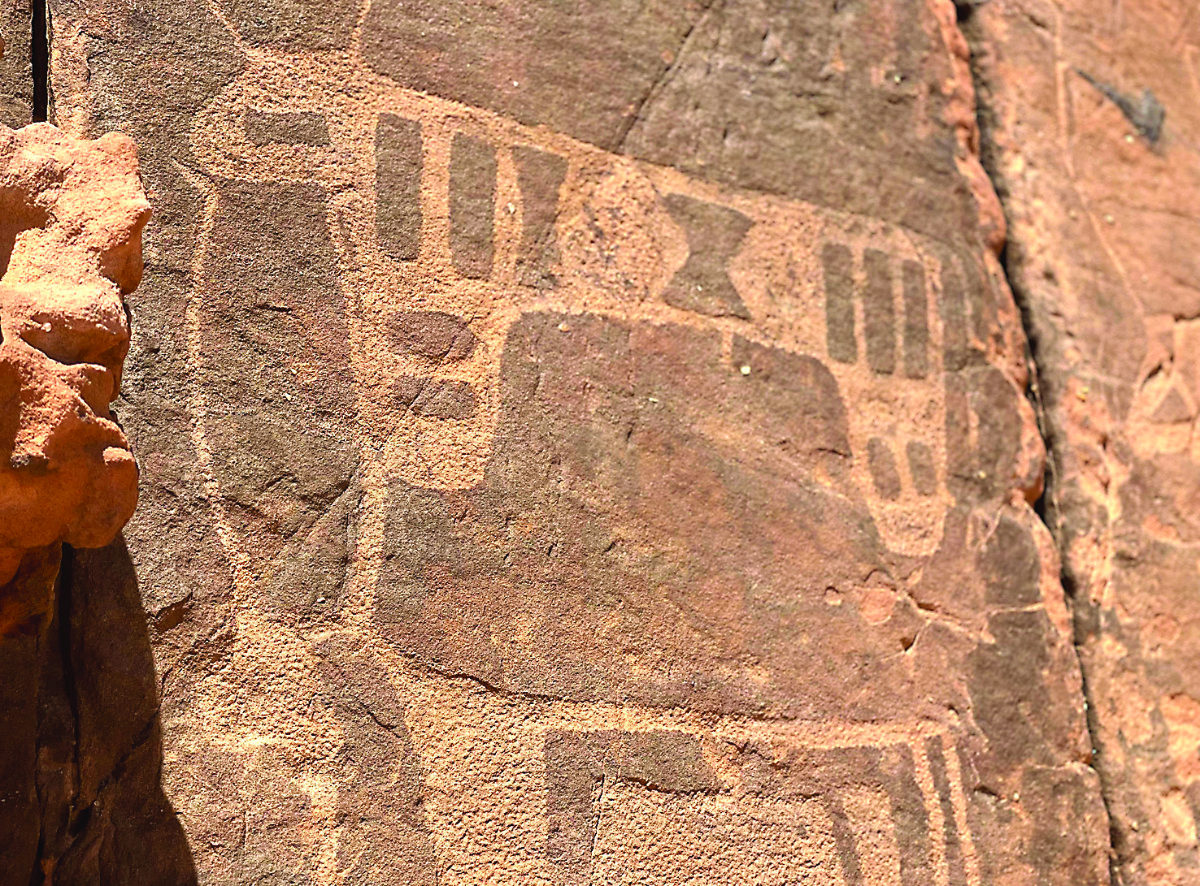
Abdulelah Al-Fares, a photographer and expert in ancient artifacts and a member of the Saudi Heritage Preservation Society, told Arab News that the rock art is in the mountains and plateaus in NEOM, part of a mountain range in the northwestern part of Tabuk.
Hisma Desert is bordered by the Sharah Mountains to the north, by Wadi Araba to the northwest, by the Hijaz Mountains to the west, and by Harrat Al-Raha to the south.
HIGHLIGHTS
• Studying rock art in the region matters deeply because it reveals economic and cultural changes that shaped the northern Arabian Peninsula.
• The drawings show how people interacted with now-extinct animals in the area, as well as with livestock and camels.
• Among the standout examples are life-sized camels crafted with remarkable precision and aesthetic detail.
“The plateaus, part of the Hisma Desert and its geological formations, represent an open-air museum of nature, ancient rock art, and diverse historical inscriptions,” he said.
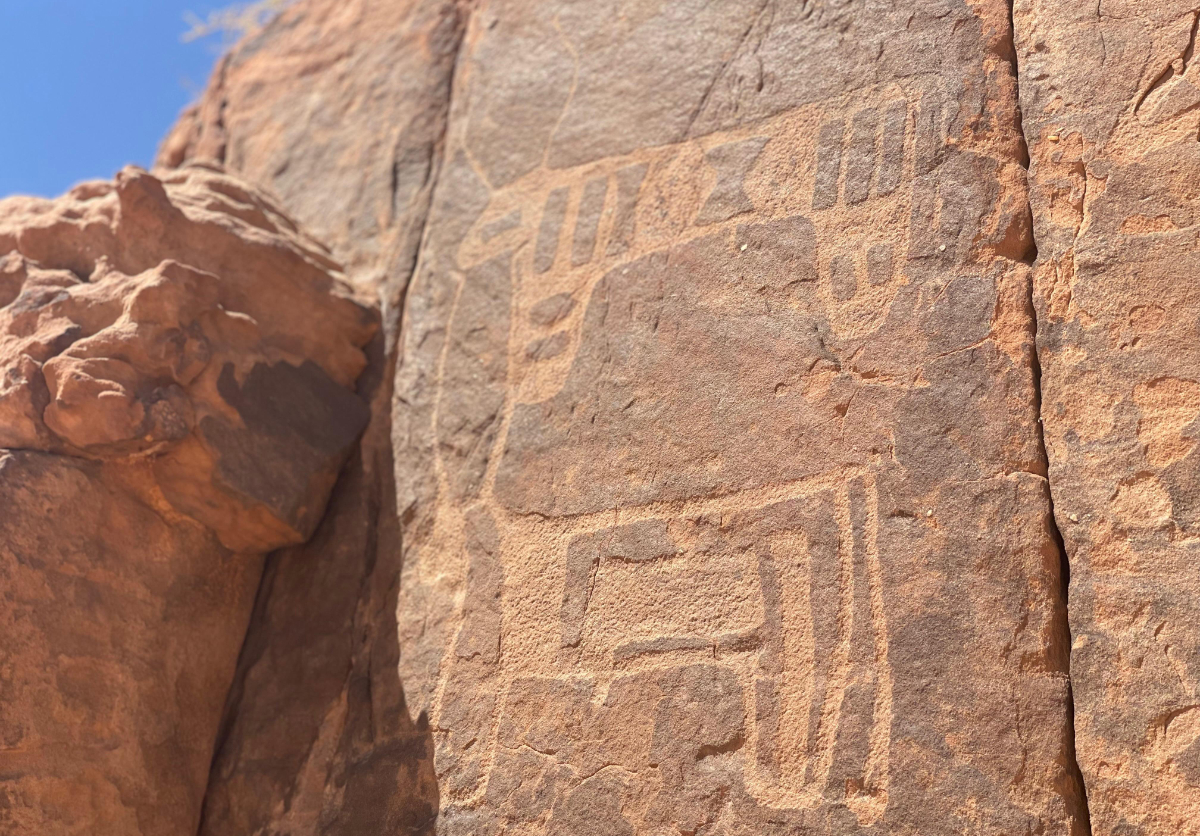
The rock drawings feature engravings of human figures, animals and various scattered scenes throughout the site.
The engravings on the plateau’s facades depict scenes of animals, including wild animals such as camels, cattle, ibexes, ostriches and wolves, as well as other predatory animals, and depictions of hunting scenes and human combat.
These drawings are notable for their precision and have remarkably withstood the elements for thousands of years.
Abdulelah Al-Fares, Saudi Heritage Preservation Society member
“These drawings are notable for their precision and have remarkably withstood the elements for thousands of years,” he said. “Most of the themes and scenes in some of the rock drawings in the region are repeated and depict, to some extent, the world of wild animals and the interactions of humans through hunting and warfare.
“The mountains embody a civilizational and cultural legacy through their distinctive rock drawings featuring human and animal forms,” Al-Fares said.

He also highlighted the value of exploring NEOM’s ancient rock art. These carvings — depicting animals, hunting scenes and human figures — are a bridge between our modern lives and the world of humans thousands of years ago. They are a source of cultural and historical knowledge.
The artworks also illuminate the journey of human civilization, revealing its cultural and social evolution in the region.
Scattered throughout the area, a wide array of rock art sites show a vast and dense collection of drawings and archaeological inscriptions from different eras etched on mountain surfaces.
Al-Fares pointed out their diversity, noting the varied artistic styles, forms, and themes that distinguish each piece.
Among the standout examples are life-sized camels crafted with remarkable precision and aesthetic detail. The careful attention to detail is thought to underscore the camel’s role as an essential sources of food and transport in ancient times.
Another façade shows a herd of cows, all facing forward, their large crescent-shaped horns curving at the tips. Encircling this herd, human figures of varying sizes are skilfully carved.
These ancient artworks are pictorial panels of human history, activity, environmental adaptation, and cultural development during ancient times. Their value shines brighter given the scarcity of insights into prehistoric life.
Studying rock art in the region matters deeply because it reveals economic and cultural changes that shaped the northern Arabian Peninsula.
The drawings show how people interacted with now-extinct animals in the area, as well as with livestock and camels.
Many carvings portray human beings astride animals, including a warrior wielding a spear and sword, rendered with finesse and skill.
Scattered throughout the region, some drawings hint at the presence of different ethnic groups that lived in the area. The provide clues to migratiosn and trace the routes of trade caravans that used these locations as settlement points.
Saudi Arabia’s Hail poppy reserve attracts thousands of tourists

- Since opening in 2022, the reserve, which covers 10,000 sq. meters, has drawn thousands of domestic and foreign visitors
HAIL: With its vibrant array of wildflowers framed by golden sand dunes and majestic mountains, the Poppy Reserve in Al-Khattah is one of the Hail region’s most captivating attractions.
Since opening in 2022, the reserve, which covers 10,000 sq. meters, has drawn thousands of domestic and foreign visitors, particularly during holidays, Eid and the spring season.
The attraction enchants guests with its sweeping fields of poppies, perfectly balanced in form and color. As the sun sets, the golden rays cast a warm glow over the landscape and create a natural wonder.
This striking beauty enhances the region’s reputation for breathtaking scenery and offers a unique experience.
Madinah Retreats: Culture, spirituality to power up the soul

- Paradigm shift blends wellness practices, cultural expeditions, spiritual experiences
JEDDAH: In the sacred embrace of Madinah, one of Islam’s holiest sites, a new culture-oriented wellness experience is offering a journey that integrates spirituality, culture, and heritage.
The inspiration behind Madinah Retreats stems from founder Moatassem Al-Bitar’s experience in the wellness and spiritual tourism industry in Saudi Arabia and beyond.
Recognizing key gaps in traditional retreat models and leveraging Saudi Arabia’s tourism vision, he envisioned a paradigm shift that blends modern wellness practices, cultural expeditions, and spiritual experiences into a single journey.
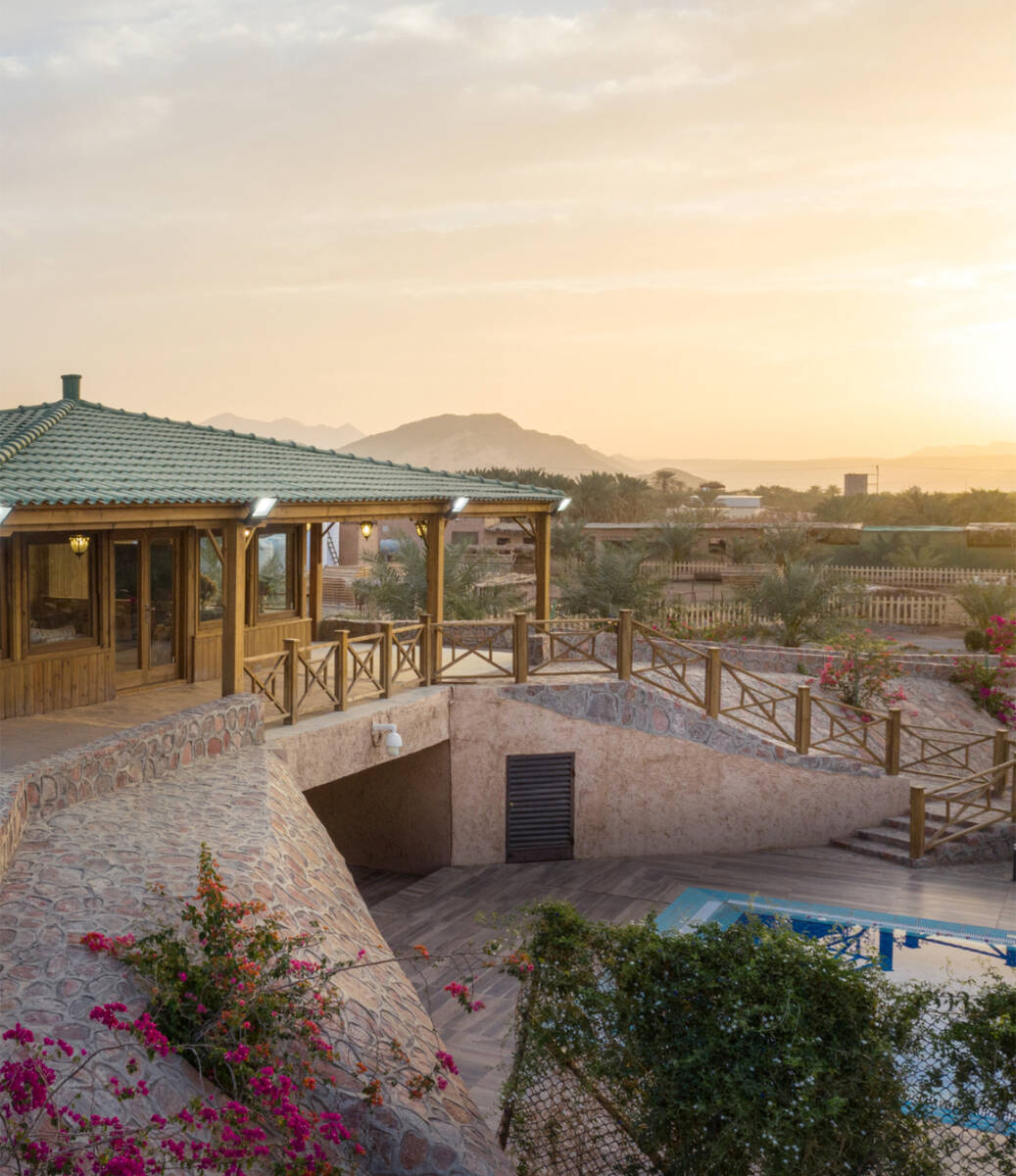
With a background as a corporate culture change and people engagement manager, Al-Bitar has curated over 50 retreats across Saudi Arabia, Egypt, and the US, serving more than 400 participants.
His academic training spans diverse fields, including organizational behavior, Islamic spirituality, and intercultural studies.
Officially launched in 2024 after five years in the making, the initiative held its second retreat, under the theme “The Arrival,” earlier this year in Madinah.
FASTFACTS
• Madinah Retreats stems from founder Moatassem Al-Bitar’s experience in the wellness and spiritual tourism industry in Saudi Arabia and beyond.
• It blends modern wellness practices, cultural expeditions, and spiritual experiences into a single journey.
Al-Bitar told Arab News: “Every retreat we design starts with clear intentions and objectives, supplemented by a story and a theme that aligns with a particular destination.”
The retreats feature a collective of facilitators who work together toward a unified intention, ensuring a balanced and immersive experience.
“One of our main goals is to promote different destinations in Saudi Arabia that are perfectly ideal for wellness-centric experiences, in addition to its unmatched culturally enriching character,” Al-Bitar said.
“We seek to partner with pertinent governmental initiatives and entities that fulfill the Kingdom’s Vision 2030 for wellness tourism and exceptional experiences.”
Al-Bitar explained that each retreat is meticulously structured around three core pillars: spirituality (meditative practices and inner reflection); culture (heritage site visits, traditional storytelling, and local experiences); and wellness (movement–based practices, mindfulness exercises, and healing foods).
By integrating these elements into daily programs, Madinah Retreats offers a journey tailored to the needs of participants and is a “philosophy of being rooted, real, and rich.”
The retreats target individuals and groups seeking genuine transformation in their well-being, spiritual connection, and cultural enrichment. They provide a safe and accepting space where participants are respected on their unique paths to healing.
Madinah, which is the spiritual capital of Islam, is popularly known as the Illuminated City. It offers an atmosphere of peace and rejuvenation, and its diverse topography and climate make it ideal for nature-based healing.
“Madinah is widely recognized as a destination where the heart feels at peace, the body feels rejuvenated, the mind feels clarity and the soul feels enriched,” said Al-Bitar. “The city’s rapid development and recognition as a top global tourism destination further enhance its appeal.”
The Madinah Retreats experience is usually hosted in a traditional farm resort surrounded by nature. Participants visit cultural and historic sites, explore the city’s vibrant social scene, and experience local cuisine, contemporary art, and community traditions.
“During the retreat we offer meditation, breathwork, self-reflection, yoga, tai chi, and other somatic therapies, creative expression as a healing tool, as well as locally sourced, nourishing meals,” Al-Bitar added.
The somatic practices guided by expert facilitators enhance body awareness and overall well-being.
Al-Bitar said: “Connecting with nature and animals has proven therapeutic benefits. Madinah Retreats incorporates nature-based and equine therapy to help participants reconnect with their original disposition, providing an irreplaceable form of healing.”
Cultural storytelling is also an essential component, allowing participants to explore the hidden wisdom of each landmark and understand local traditions and historic practices.
No prior experience in meditation or wellness practices is required, making the retreats accessible to all.
Honoring his Egyptian roots, Al-Bitar is expanding the retreats to Siwa, Egypt.
Siwa Oasis, nestled within a breathtaking desert landscape, is characterized by vast dunes, striking limestone outcrops, and distinctive geomorphological features that enhance its appeal as a tourist destination.
“The expansion to Siwa, Egypt, was inspired by the oasis’ 160-year-old tradition of reconciliation — Eid El-Solh, a celebration of harmony,” Al-Bitar said.
“Siwa’s natural healing elements, such as salt lakes, hot springs, and lush landscapes, mirror many of Madinah’s restorative qualities.”
Al-Bitar said that Madinah Retreats will also explore the Kingdom’s hidden gems by hosting retreats in Abha, Aseer, Al-Ahsa, and other locations rich in healing nature and cultural heritage.
Retreat prices range from SR5,000 ($1,333) to SR10,000, depending on the location, program, facilitators, transportation, and accommodation.
Madinah Retreats follows a collaborative model, partnering with local service providers, facilitators, and experts to provide an experience that remains true to the cultural essence of each destination.
Al-Bitar said: “Our content caters to people from different backgrounds, both English and Arabic speakers. Our agenda is characterized by being spacious and offers ample time for self-guided practices. Our way of delivery is strictly non-intrusive.”
Participants leave Madinah Retreats feeling “transformed, enriched, and connected to their most authentic selves.”
Al-Bitar said that the experience embodied the profound wisdom: “You presume you are a small entity, but within you is enfolded the entire universe.”
Madinah Retreats also provides a customized retreat model that caters to corporations and teams, as well as add-on visits such as expeditions in AlUla.
High-end design with luxury service: The Jeddah Edition

JEDDAH: With its sleek, contemporary design that combines modern luxury with understated elegance, it’s no surprise that the Jeddah Edition won Best Hotel Design at last month’s Saudi Commercial Interior Design Awards.
The high-ceilinged lobby is gorgeous — its orange acrylic sphere, created by Vincent Leroy, really pops against the sunset and created such a perfect vibe as I walked in.

The welcome was as impressive as the surroundings, with Saudi coffee and dates served before I’d even checked in. The check-in process was smooth and efficient, setting the tone for a relaxed and enjoyable stay, throughout which the staff were always friendly and quick to respond to any requests, ensuring visitors feel well taken care of.
My spacious deluxe room, thoughtfully laid out, instantly made me feel at home. The beige-and-white color scheme, balanced by the perfect lighting, created a calm and comfortable environment, while the bathroom’s freestanding tub and signature Le Labo toiletries added a touch of luxury.
In the evening, I headed down to the Lobby Bar to grab a light snack. The atmosphere was lively — there’s a snooker table and a selection of games for guests to enjoy — but cozy too, with blankets and shawls draped over the comfortable sofas. I sampled some of the delicious snacks, including vegetable spring rolls and zucchini chips paired with a brinjal sauce dip, before heading out for a stroll around the nearby art promenade.

While there are many excellent dining options within the hotel, its location near the Jeddah Yacht Club and Marina provides easy access to a variety of great spots, ideal for foodies.
As night fell, I made my way to the poolside lounge on the Edition’s roof terrace. This quickly became one of my favorite spots, with its panoramic views of the marina and the Formula 1 racetrack.
In the morning, I indulged myself with a relaxing massage at the hotel’s Aromatic Spa, an experience which began with a refreshing cup of lemon mint tea with a few drops of chamomile. The spa facilities were immaculate, with separate changing rooms and bathrooms. For couples, there’s a special treatment room that includes a private balcony.
The food at the hotel was excellent. At the Maritime restaurant, which serves a contemporary French-Asian menu, there are breakfast and lunch buffets, while for dinner, the à la carte menu offers a selection of dishes designed for sharing. I was particularly impressed by the monkey bread, shrimp dumplings with lemongrass beurre blanc and caviar, lamb shank, and perfectly cooked beef short ribs. The restaurant’s terrace, framed by pink bougainvillea and 150-year-old olive trees, and with views of the Red Sea, provided an exceptional setting for dining.
After eating, I headed to The Den, a cozy lounge perfect for those looking to unwind with a cigar or enjoy a light drink. With tufted teal velvet banquettes and a classic ambiance, The Den is an intimate setting that contrasts beautifully with the lively energy of the rest of the hotel.
There were several other amenities I made use of, including a well-equipped gym and the rooftop pool. Sadly, the latter, while an excellent spot to relax under the warm Jeddah sun, isn’t really large enough for anyone wanting to get some proper swimming in.
That was a minor gripe, however, and overall my stay at The Edition was an experience I would be happy to repeat. If you’re looking for a relaxing, luxurious stay in Jeddah, it’s hard to beat.






















